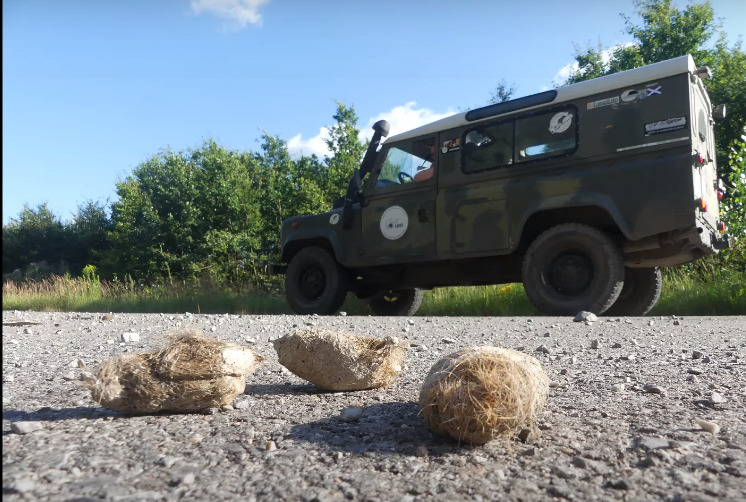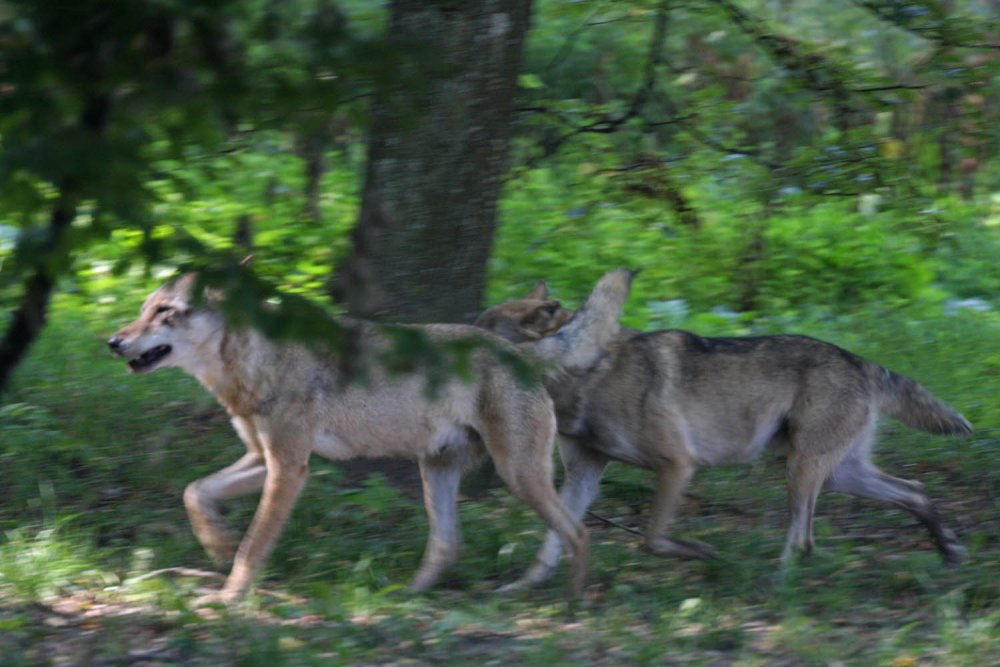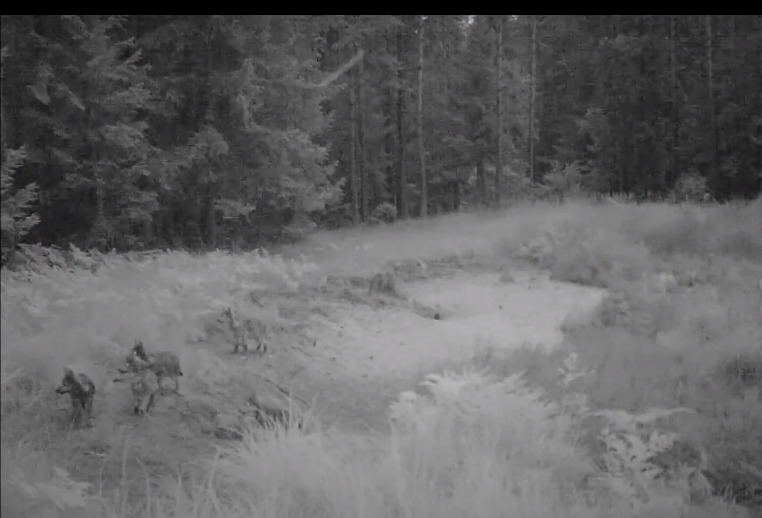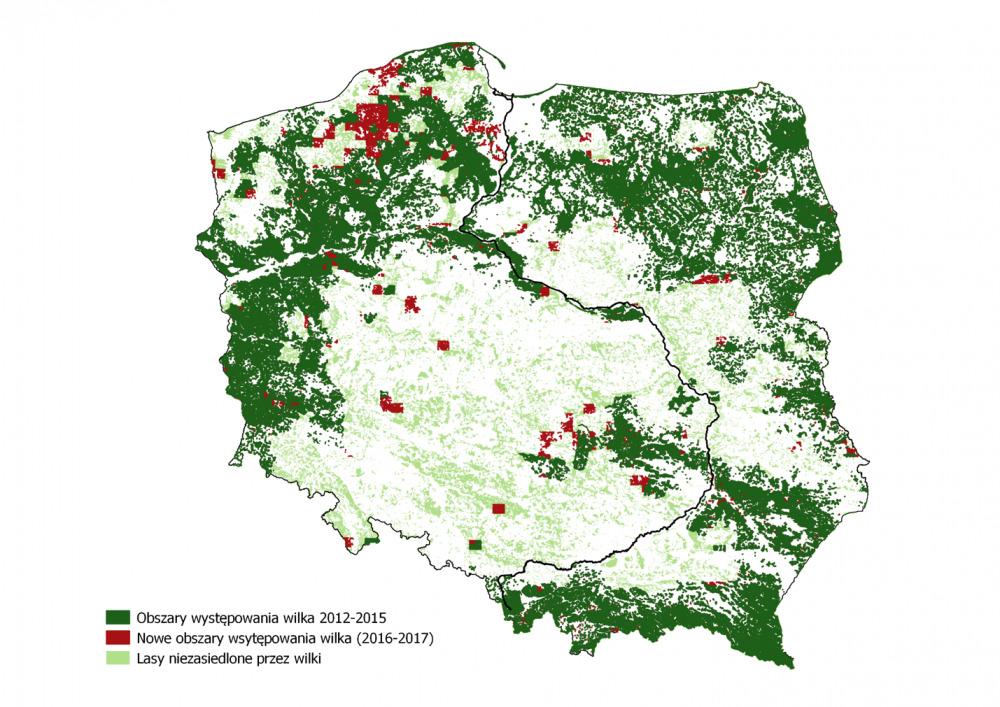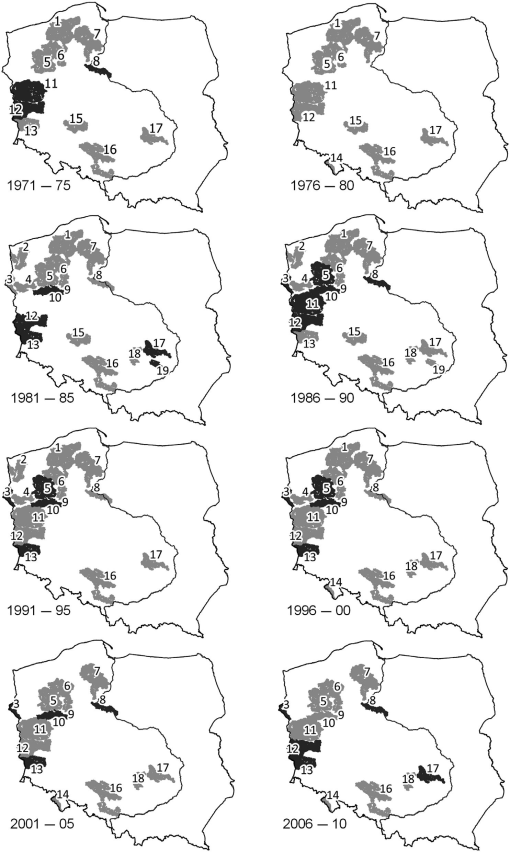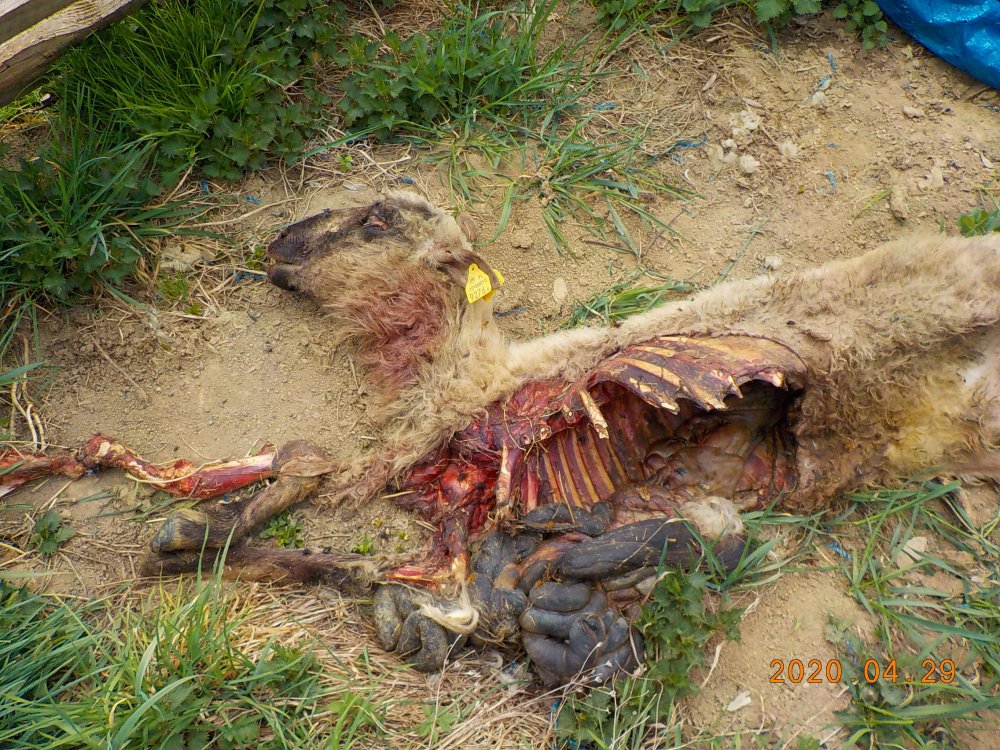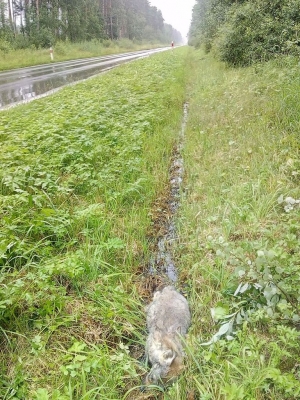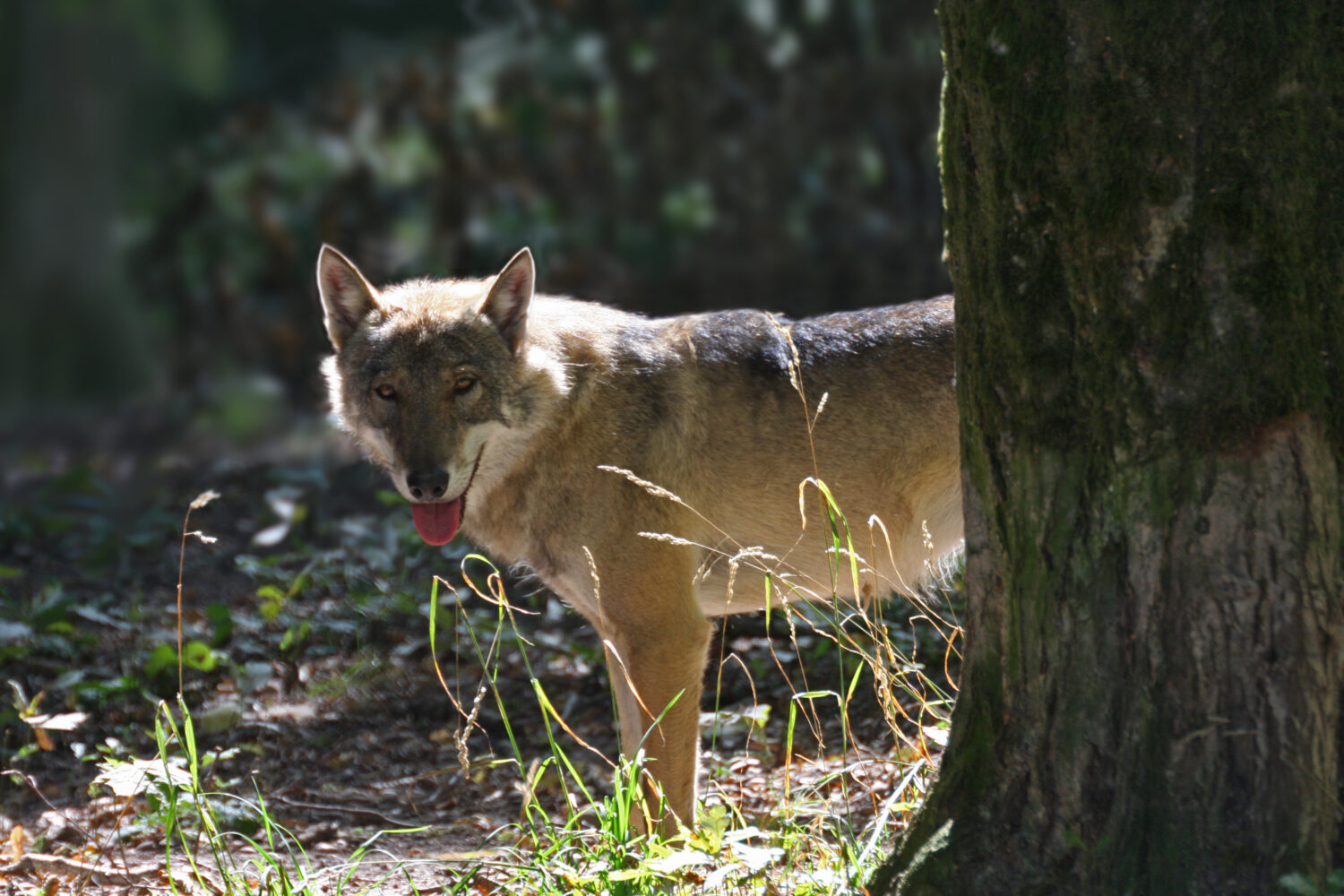Wolves in the Bieszczady National Park
Wolves in the Bieszczady National Park
In the latest issue of Roczniki Bieszczadzkie we have published the results of wolf monitoring in the Bieszczady National Park and the Park’s buffer zone. In the years 2006 – 2020, we were monitoring 4 wolf family groups living in the area of 903 km2 using tracking, telemetry and photo-traps. The number of wolves ranged from 15 to 45 individuals, with densities of 2.6-3.0 individuals/km2. The monitored packs were raising 4 to 10 pups. Wolves hunted mainly deer (84%), wild boars (10%) and roe deer (5%) and occasionally small mammals.
Details in the article: B. Pirga i T. Polakiewicz 2020. Dynamika liczebności grup rodzinnych wilków Canus lupus w Bieszczadach Wysokich w latach 2006-2020. Roczniki Bieszczadzkie 28: 69-94 .
Wolves among the fields
Wolves among the fields
The forest complex located to the north-east of Iłża is part of the Marcule Forest District, but is surrounded by arable fields and is separated from the Iłżecka Backwoods. In June, we received information from the chairman of the hunting club, Waldemar Gieraziński, that one of the hunters was observing three pups with a she-wolf in this area. On July 10 in the evening, I howled for the first time (Jacek Major) in this area, but I was unable to receive the wolves’ response. However, I found quite a lot of traces of their presence – scats and tracks. On July 27, we re-inspected this area. During the tour through forest roads, we found tracks and scats of wolves and a wolf’s den that was used this year. It was situated on the edge of a largely untraveled forest road, the edges of which were covered with hazel. In spring, the entrance to the den was covered with a large hazel bush and was hardly visible even from a short distance. We were able to spot it while driving an off-road vehicle only because some time ago (about 2 weeks), the hazel was cut with a machine for cutting bushes along the ditches. After finding the den, we were more optimistic about the chances of getting a response to the howl we planned in the evening. Driving around the roads, we found a lot of scats. Their number was especially large on one of the asphalt forest roads crossing the complex. At sunset, around 8 pm, we howled right from this spot. We received the answer from the whole wolf family. 3 pups and at least 4 adult wolves howled!
We obtained information from foresters from this area (Michałów and Podrzecze forestry) that wolves appeared in this area already around 10 years ago. Initially, these were occasional observations, but in recent years they have been seen more and more often.
Jacek Major and Roman Gula
Wolves in Stara Dąbrowa
Wolves in Stara Dąbrowa
This summer, I had the opportunity to study wolves in a very charming place in the Lubuskie Province. The Natura 2000 area “Stara Dąbrowa w Korytach”, located several kilometers west of Świebodzin, is a small (16 km2) part of the huge Rzepińska Primeval Forest. It is also one of the few places in Poland where we can still see the beautiful old-growth oak forest. Wolves are under protection in this area; therefore, as part of the Conservation Action Plan [Plan Zadań Ochronnych], their number should be estimated. However, determining the number of wolves in just one month, in the summer, when there is no snow, seems to be impossible. In this situation, the only thing left for me was to record the wolves in photo traps.
Due to its small size, this area may constitute only 5-10% of the wolf family acreage, so when installing photo-traps, I was not expecting many videos with wolves. However, the wolves surprised me – when I came back after a month to check the cameras, it turned out that they had recorded each of them several times! On the night of August 16, a group of 4 wolves was recorded on two photo-traps located on a forest road 2, 2040 m away, 15 minutes apart. This means that they were traveling at a speed of over 8 km/h. As you can see in the recordings, the wolves not only trotted but also stopped at crossings to mark their territory with their smell. As we showed in our article on the use of roads by wolves in Bory Dolnośląskie, the speed of wolves traveling on roads depends on the roads’ quality – on paved, main forest roads, it can be several times higher (on average 21.5 km/h) than on overgrown, side lanes (on average 5.4 km/h).
I would like to thank the employees of the Świebodzin and Torzym forest districts for their help in fieldwork.
Katarzyna Bojarska
Young and adult wolves recorded as a photo-trap in Stara Dąbrowa (Rzepińska Forest) - video
Pups in the Iłżecka Forest and the Lipie forest complex
Pups in the Iłżecka Forest and the Lipie forest complex
As every year, in the summer, we try to determine whether the wolves breed in the Iłżecka Forest and the Lipie forest complex. In the Iłżecka Forest, the wolves responded to my howl on July 27th. Four adults and three pups howled. Two pups were observed on one of the forest roads on August 3rd. I also noted wolf tracks and scats many times, and several times I managed to record wolves on a photo-trap. The family from the Iłżecka Forest has been breeding regularly for many years and we manage to confirm this every year.
In the Lipie forest complex (the area from the DK 9 road west to Skarżysko Kamienna), foresters observed the presence of two pups. Unfortunately, on July 11th, one of the youngsters died as a result of a collision with a car on the DW744 road leading to Tychów (we wrote about this note on July 15th, 2020). So far, we have not been able to confirm if there were more than two pups and if any of them survived. Unfortunately, the area occupied by this family is intersected by two roads with quite large traffic – the aforementioned DW744 and the Wąchock-Mirzec road. Also, in this forest complex, we recorded adult wolves in photo-trap several times, and we recorded tracks and scats of wolves many times.
Jacek Major
A family from the Świętokrzyska Forest is in good shape
A family from the Świętokrzyska Forest is in good shape
In July, a forest worker encountered several wolf pups on one of the forest roads of the Świętokrzyska Forest. According to him, there were as many as nine of them. On August 1, we managed to get a spectacular response to our wolf howls from the Forest. Five adult wolves responded. Howls were coming from distinguishable directions – the difference between the extreme individuals was as much as 90 degrees. After a while, the pups also started howling. It was hard to count how many – they were howling from one direction – but you could distinguish at least the first four phases. In the first weeks, we managed to record several adult wolves and pups from this family in a photo-trap. In one video sequence, there were up to two pups appearing simultaneously.
Roman Gula and Artur Milanowski
Pups and adult wolves from the Świętokrzyska Forest - video
Young wolves in the Augustow Primeval Forest
Young wolves in the Augustów Primeval Forest
Similarly to last year, we confirmed the presence of three wolf packs rearing pups in the Augustów Forest District. The “Tajno” pack occupies an area outside the dense complex of the Augustów Primeval Forest, on its southwest edge, and part of its area is located in the Biebrza National Park. This group, along with three pups about three months old, was observed at the end of July. The family tried unsuccessfully to hunt a deer – a goat. The “Klonowo” pack, occupying the territory in the south-western part of the Forest, is exceptionally secretive this year and can be rarely observed. Nevertheless, we managed to spot two young wolves. However, most information was gathered about the young members of the “Augustów” pack. We have been encountering them in the central part of the Forest for several weeks. We managed to capture them in photo-traps, while playing, drinking water, and even howling. Usually, five pups were registered, but it turned out that there were six of them. In the other parts of the Augustów Primeval Forest, so far, we have managed to confirm pups in further two wolf packs.
Joanna Harmuszkiewicz
Six pups from the Augustów pack - video
Do wolves present in the Polish lowlands belong to two different populations?
Do wolves present in the Polish lowlands belong to two different populations?
In 2008, the European Commission proposed the division of wolves occurring in the Central European Lowlands into two populations – the Baltic and Central European ones, and the border between them was marked along the Vistula River. Among the arguments for the separation of the Central European population, the most important were: the history of this population (revival in the 2000s after total extermination in the 1970s), lack of connection with the Baltic population, and genetic distinctiveness. As a consequence, the new population was given a higher endangered status, in contrast to the Baltic population, which was considered to be the least concerned population. This division was never implemented in the wolf conservation practice in Poland, and its sense raised doubts from the very beginning.
In the latest issue of Wildlife Biology , we have published an article in which we re-evaluate the distribution of the wolf population along the Vistula River. First, we are presenting information from 14 publications and unpublished data on the occurrence and reproduction of wolves in western Poland in the years 1970-2010. They demonstrate that the wolves west of the Vistula have never been exterminated and have reproduced in this area. The slow increase in the abundance and range of the species in this area began, as in the rest of the country, after the wolf status changed from pest to hunted species in 1975 and accelerated after wolves became protected in 1995. Interestingly, the structure of the wolf habitat is more favorable in the west than in the east of the Polish lowlands. Forests cover about 32% of the area (27% in the lowlands east of the Vistula), and the forest complexes are much larger. The habitats of wolves on both sides of the Vistula are connected in several places, and the Vistula valley itself is also a convenient wolf dispersion corridor. Therefore, the Vistula River is not a barrier that would divide the wolf population. The results of all genetic studies conducted before 2020 also indicate that wolves living on both sides of the Vistula constitute one population. The latest genetic research published in 2020 appears to contradict this, but it is due to a misinterpretation of the results.
In 2017, when we made this analysis, wolves inhabited approximately one-fifth of Poland’s territory (61,940 km2). The wolf acreage in the lowlands, west of the Vistula, accounted for almost half of the wolf habitat (approximately 30,220 km2), and in the lowlands east of the Vistula only 23,550 km2. The area in the Carpathians is another 7,670 km2, and wolves also inhabited the Sudetes (510 km2). Wolves in the west have not yet inhabited 8,800 km2 of forests in the west, which seem to be a favorable habitat for this species (sufficiently large complexes and a sufficient number of ungulates). In the lowlands east of the Vistula, there are about 8 times fewer such environments (1,100 km2). This indicates a more advanced recolonization in eastern Poland. This is probably due to the fact that the recolonization of wolves in the Polish lowlands was strengthened by individuals from beyond the eastern border of Poland.
To sum up, the division proposed by the European Commission has no substantive justification, has never been applied in practice, and we propose that wolves on both sides of the Vistula should be treated as one population and have the same protected status. Differentiation of conservation status can be a useful tool but should rather apply to smaller areas where wolves are indeed more vulnerable for various reasons, such as where they are just beginning to re-colonize. Such areas are located on both sides of the Vistula.
Roman Gula and Katarzyna Bojarska
Podkarpacie - damage to livestock in the first half of 2020
Podkarpacie - damage to livestock in the first half of 2020
In the first half of 2020, there were 47 wolf attacks on the farm and domestic animals in Podkarpacie. This is 13% less than in the first halves of 2019 and 2018 when wolves attacked 54 times. Sheep were the most frequently attacked species – 24 times. In addition, wolves attacked dogs – 3 times (cases where remains or other traces confirming the killing of dogs were found), cattle – 3 times, horses – 2 times and a goat. Wolves also attacked deer and farm fallow deer multiple times (14 times). There were more attacks on dogs, but they were non-purebred dogs for which there is no market valuation, and therefore, they are not included in the statistics. In addition, the wolves damaged the property’s fences during an attack on a large non-purebred dog (German Shepherd crossbreed), as well as during a hunt on deer – bull in the center of one of the villages.
Detailed damage data is available at RDOŚ in Rzeszów.
Hubert Fedyń, RDOŚ in Rzeszów
Pups in the Lipie forest complex
Pups in the Lipie forest complex
We recently wrote about the wolves recorded in the Lipie complex in the note from April 17. On the 4th of July, one of the foresters from the Starachowice Forest District was observing 2 of this year’s pups in these forests. This is the first observation confirming our assumptions that wolves also breed in this forest complex. Unfortunately, on July 11, foresters found a dead pup in a ditch on the busy DW744 road leading from Starachowice to Tychów. She was a female approximately 10 weeks old. The examination demonstrated that she died as a result of extensive damage to the front part of the body, probably as a result of a collision with a car. She weighed 8 kg and was in good shape.
Roman Gula, Artur Milanowski and Jacek Major
Wolves in the Kozienice Forest
Wolves in the Kozienice Forest
A spokeswoman for RDLP Radom informed us about the presence of wolves in the area of the Forest District of Zwoleń. We contacted the employees of the forest District who recorded the presence of wolves in the Kozienicka Primeval Forest in Uroczysko Miodne (Zwoleń district). The first sighting of a wolf in the local area took place in the fall-winter 2016/2017 season, during a collective hunt in the Motorzyna and Podgóra forest districts. From 2017, single individuals were seen in these forest districts and the Patków forest district. Other traces of their presence (howling, tracks and scats) were also constantly recorded. Foresters have also found wolf prey many times. Most often, those were roe deer and deer, but the prey of these predators was also a moose calf and a domestic dog.
Recently (June 2020), two individuals were found in the Patków forest district (direct observations). One of them was recorded by an employee of the forest district office with a mobile phone. Permanent observations of wolves, the abundance of game and the presence of calm and poorly accessible forest fragments (numerous peat bogs and alder forests) suggest that these predators may already reproduce in the Kozienicka Primeval Forest.
Tomasz Bracik
Wolf recorded with a mobile phone in the Forest Inspectorate of Zwoleń in the Kozienicka Forest



